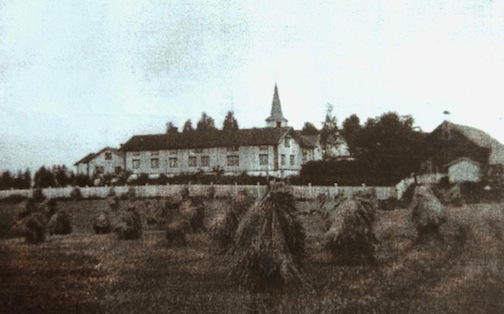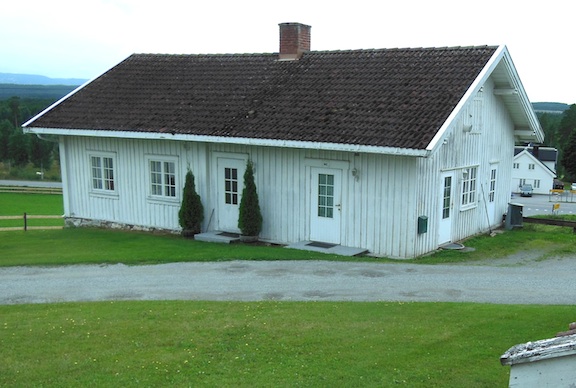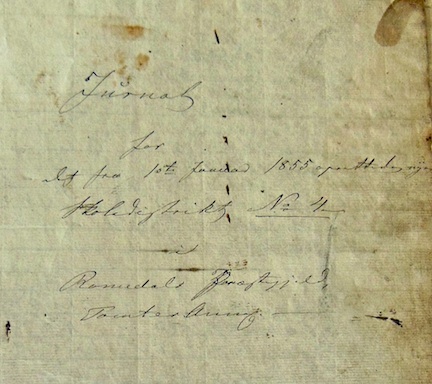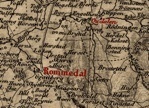Tomter
Gardsnr. 348 (138)
Old stavemåter av name: Tomt e 1520, Thomte-
Tomopte 1570-80 AaRa. Thombte
1563, 1604, Tombter 1669. Tomter
from the 1723rd
Original spelling faithfully is Toimtu,
is plural for house sites.
A will or here a reproduction of the professors
study of farm names-operation on this name group.
Sitatet is download from Rygh - forard and
Indledningsun n. (Gen. tuns, Dat. Tuni. Fit. In Gaard
Names Tunir f.) Have orig. Meant: Gjerde (same word as
German pepper Zaun), then: fenced place. It may have
been possible that it had this meaning even in the
oldest of the Norwegian Names in which it appears. In
Norway in the historical time it has been referenced
to the yard on a farm (because it was fenced) ,,
partly also with inclusion of the surrounding
buildings (hence the west country on the different
parties or Use In in Overgaard). Compositions are both
in wine (Tunin, Tuninjar) and heimr (Tuneimr, now
partly In The pronunciation changed to Tanum, Tannum,
Tønnum, Tonneim). Pronounced on Østandet Ton and a
confounded with it under two mentioned Toen; the 2nd
joint often shortened to - tu or - to.
Tupt or topt f. (Gen. tuptar, Flt. Tuptir),
house-remnant. The names most USMS. Often I Flt., Or
as the last generation. Currently, in the largest part
of the land now gone over to the ft. As Page Former
occur in medieval Earth Books typt. Emptied. Tumt,
tymt, emptied (forms with mt jevnlig written with it f
or p diss between two consonants); there answer as
Present Forms Tøft, empty (pronounced partly with
lukt, partly with open Vocal) Empty, in some places
Temt. Can names have not always skkert separated from
one tribe oopt, of uncertain significance, hvoraff.
Ex. It acquaintances Tofte (Ooptin) In Dovre Coming. "
Tax lists of 1647 called Tomter for half yard of 2 hides
debt. The farm belonged to the Romedal priests farm,
the tenant farmer was Peder Thombte who paid three
dollars I skatt.
The tax list 1668-69 collected from Tomter for
2 hides or 3 quarters of rye flour.
The farm belonged to Romedal priest lands, the tenant
listed was Christen Olsen and aetta banquets he lived
long in Tomter. Christen sowed 4 0.5 ton of cereal, he
had one horse of 10 cattle. He paid three dollars in
tax, 2
tonner of one quarter each thing in tithing, 1 mark In
flax, 2 skilling In vissøre of 1 mark in building
money.
Enga is called barren, it was jointly owned
forest with neighboring garden and seats it
harabotten.
The Land Register of 1723 call garden "Plots with
underlying Staarslaater" and puts it in half gard
checkout. It was ancient priesthood gods. Bygleren is
not named, but it was enough Jorgen Eriksen.
Garden lay Sollies with lightly used and dry sides
soil. It had a forest to fence with difficulty, by and
hustømmer. Setra - probably Harabotten - haddle
måteliig good harbor.
Garden Fodder 2 horses, 14 cattle, 10 sheep and 8
goats. It was planted 4 bushels rye. 2 tonner
construction, 3 barrels of oats and 4 bushels peas. On
star haying were harvested 2 hay, at the garden, here
were sown 2 bushels of oats.
Skyda On Land was continued with two hides.
The Land Register of 1787 call Plots for a half farm.
The assessment is 2 hides and garden belong untaxable
Romedal prestebol, Jorgen Eriksen was bygselmann.
Tax Commission 1802: Half-farmd of 2 hides or 1 skpd.
fault. Garden was assessed to 1,200 rdl, marital gift
of 4 rdl. And 90 shillings. Romedal priest land owner
was Lars Jorgensen who was a barley farmer.
Land Commission 1818-1819: Land owes 1 skpd. Heavy
comparative figures 20 Owners and land users as it
1802. L. No.. 141, matr. No. 18.
The Land Register of 1838: Land had an old debt of 1
skpd. Heavy, new fault 7 dallars, 2 ort and 15
shillings. Owner and user Ole Larssen.
The Land Register of e 1865: Land debt and
ownership In 1838, area totaled 18 then. Field,
154 then. Eng, 23 then. Dyrkbarjord, 167 then. Harbor
and forest, 350 then. Forest Soil and 210 when star
forests. One twentieth of field value was less because
of frozen.
The Land Register of 1888 has the old monetary debt in
dallars, ort and skilling also steady led five new In
worms and ear. Alongside matrikkel number is also the
new farm and user number Infort: 138-1. Gammerl guilt
7 dallars, 2 ort and 15 shillings, new fault 13 mark
and 4 cents. Owner and user Severin Olsen.
The Land Register of
1903 two were operating In Land. Br. No. 1 of
guilt 12 mark and 80 cents. Owner and user Severin
Olsen. Br.nr 2 Land Engen of guilt 24 cents. Owner and
User ole Engebretsen.
Garden plots mentioned in difference ingested tax
rolls in the 1500s. Garden must still, under reference
attracted the Professor Rygh writes in Norwegian
Garnavne, about
medieval elders.
This garden has voted through the ages as very
important, a central position in historical
consciousness. At the church of the parish remained -
and lies. It is not inconceivable that is was a place
of pre-Christian worship - a hoof (or pagan lodge) may
have stood here.
The parish name has been Tomter parish. Still there
are many, both of old and younger, who call it the
Vallset church as "Tomt-kjorka". Now it'd be worship
in Vallset church, said one might assume that there
would be "Tomt-mess".
Peder Pedersen called the first user with a familiar
name here on Land. He paid land rent and of second
avjifter of Land in the years 1612 - 1653. In
1628-1629 he paid inheritance tax of garden emd 1
mark. Land mat therefore subject to flat then be his
heir farm. Peder in 1641 pay 13.5 valleys in fines for
a brawl.
Peder Pedersen was the brother of Tollef Pedersen
Horne. See In Vol. 1 on Horne, and see also Hedmark
Skektshistorielags Journal Vol. 4, page 79
Peder personal mark is known. It has the letters P. P.
and a meandering snake.
Peder's wife called possibly Kirsti. They mentioned
with his son Lars, b. Ca. 1628. He used garden fils.
Christen Olsen paid land rent of Land 1654-1661. In
1671 forums lately he and his wife a "tablet" .-
epitaph - to Vallset church. Billboard hanging it
plots church and has the following inscription: "Dene
tafl have aerling mand Christen Ollsen, Tomte met his
dear Quinde, mari, Andresz daughter, Foraerret Tromte
Church anno 1691."
Christen Olsen Tomte was a lawyer in Romedal for many
years. Christen and Mari had five known
children, three boys and two girls. None of the boys
were using the plot, possibly because it was not
serviceable anymore, it belonged to the Romedal
Prestebol, we
guess at the history of these years. But it probably
became inherited between 1629 and 1640 to 1650
years. = - It was the eldest of the ten children,
the daughters Christen and Mari Anne Christensdtr.,
the were the offspring of the Tomte, and offspring
sitting on the farm at this date. She was married to
Erik- his surname is probably Jørgensen, but one
does not know his descent. One does not know when
Erik and Anne took over farm Tomte, they are not
mentioned there before ca. 1695. As his father was
also Erik widely utilized as court member and also
in other appointments.
The farms monumental barns of cogged timber and
a corresponding horse stable ranging from about
1860, stood on the north side of the road, up to
the churchyard wall. This outhouse building, which
had now been taken out of the farm use, was still
in good condition and was also clearly documented. It
came when in negotiations with Hedmarksmuseet and
Domkirkeodden, they had long wished for just such
a humble building of a farmyard and planned one
for museum area. The negotiations led to the
museum moving the barn, which was then
meticulously marked every timber, it was taken
down and transported to
the museum on Domkirkeodden where it has been
reconstructed, including the original compass
direction.
All that now remains on road north side, close
to the churchyard wall, were gardens storehouse.
Listed in 1905 on a different plot, moved over
to the churchyard wall and built on In 1912 ,.
This was then in 1989 moved to the new plot, it
also the road on the south side.
The area appearance after both barn
storehouse and a few smaller outbuildings had
been removed, was acquired by the municipality
as a parking lot for the church visitors. On the
way was a long-felt longing for assistance.
The farm has a historic main building, where
the oldest part is from the early 1700s, has
always been on the roads south side, It has been
in existence and added onto several times. The
decoration and detail have changed in 1980 -
presents itself it as a convenient and
functional building and housing. (This is the barn photo above
now moved to the Hamar Museum (Hedmarksmuseet and
Domkirkeodde),
And up on the height north avtunet thrones Vallset
Church - Tomt- Kjørkja so it For generations have
done.
A beautiful and evocative picture: a modern, often
busy farmyard with ferenes worship next door.
Garden Plot surface is 210 then. Arable land, 50
then, Hamen or 1050 then. Productive forest.
|













